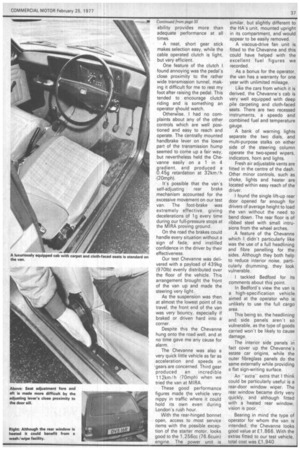nimy, comfortable to driv and light on fue RepatiStephen Grai Pictures: Dick Ros
Page 39

Page 41

If you've noticed an error in this article please click here to report it so we can fix it.
replacement for the longserving HA but is complementary to it.
Like a lot of other manufacturers, particularly the Japanese, Bedford has realised that there is a market for a light van which combines saloon car comfort with a carrying capacity of around half a ton.
These two assets will probably appeal to local traders, especially shop-keepers, who are a.to reclaim the purchase price VAT of a van but not a car • . Certainly the Cheyenne is an
testi AK recent extremely ccig;Ita,ble,, light van, and dun of the model it proved to be very economical when driven around our light vehicle reillitie
Fully laden, the Chevat completed the 37krn (23-ml circuit at an average speed of 40.7km/h (25.3mph) a returned 7.98 litre/100l. (35.8mQQ)
Half laden, consumption ys, 7.4 litre/100km (312 hip, Bearing in mind the7raffic both runs was quite hea■ necessitating a lot of stop/st work, these figures are esf cially impressive.
In fact they are some of t best ever recorded by C during the trial of a light van this size.
A further plus point of t Cheyenne is its low compri sion ratio — 7.3:1 -whi enables it to run happily two-star petrol.
Despite its low cornpressic the 1,256cc (76.,6cikin) engi develops 39.3kW (b.T.Bbhp) 5,400rom an&-its,. free revvi Continued from page 35
ability provides more than adequate performance at all times.
A neat, short gear stick makes selection easy, while the cable operated clutch is light, but very efficient.
One feature of the clutch I found annoying was the pedal's close proximity to the rather wide transmission tunnel, making it difficult for me to rest my foot after raising the pedal. This tended to encourage clutch riding and is something an operator should watch.
OtherWise. I had no complaints about any of the other controls which are well positioned and easy to reach and operate. The centrally mounted handbrake lever on the lower part of the transmission hump seemed to come up a fair way, but nevertheless held the Chevanne easily on a 1 in 4 gradient, and produced a 0.45g retardation at 32km /h ,(20mph).
It's possible that the van's self-adjusting rear brake mechanism accounted for the excessive movement on our test van. The foot-brake was extremely effective, giving decelerations of lg every time during our full-pressure stops at the MIRA proving ground.
On the road the brakes could handle every situation without a sign of fade, and instilled confidence in the driver by their effectiveness.
Our test Chevanne was delivered with a payload of 439kg (970Ib) evenly distributed over the floor of the vehicle. This arrangement brought the front of the van up and made the steering very light.
As the suspension was then at almost the lowest point of its travel, the front end of the van was very bouncy, especially if braked or driven hard into a corner.
Despite this the Chevanne hung onto the road well, and at no time gave me any cause for alarm.
The Chevanne was also a very quick little vehicle as far as acceleration and speeds in gears are concerned. Third gear
produced an incredible 112km /h 170mphl when we tried the van at MIRA.
These good performance figures made the vehicle very nippy in traffic where it could hold its own even during London's rush hour.
With the rear-hinged bonnet open, access to most service items with the possible exception of the starter motor, looks good to the 1,256cc (76.6cuin) engine. The power unit is similar, but slightly different to the HA's unit, mounted upright in its compartment, and would appear to be easily removed.
A viscous-drive fan unit is fitted to the Chevanne and this could have helped with the excellent fuel figures we recorded.
As a bonus for the operator, the van has a warranty for one year with unlimited mileage.
Like the cars from which it is derived, the Chevanne's cab is very well equipped with deep pile carpeting and cloth-faced seats. There are two recessed instruments, a speedo and combined fuel and temperature gauge.
A bank of warning lights separate the two dials, and multi-purpose stalks on either side of the steering column operate the two-speed wipers, indicators, horn and lights.
Fresh air adjustable vents are fitted in the centre of the dash. Other minor controls, such as choke, lights and heater are located within easy reach of the driver.
I found the single lift-up rear door opened far enough for drivers of average height to load the van without the need to bend down. The rear floor is of ribbed steel with small intrusions from the wheel arches.
A feature of the Chevanne which I didn't particularly like was the use of a full headlining and fibre panelling for the sides. Although they both help to reduce interior noise, particularly drumming, they look vulnerable.
I tackled Bedford for its comments about this point.
In Bedford's view the van is a high-specification vehicle aimed at the operator who is unlikely to use the full cargo area.
This being so, the headlining and side panels aren't so vulnerable, as the type of goods carried won't be likely to cause damage.
The interior side panels in fact cover up the Chevanne's estate car origins, while the outer fibreglass panels do the same externally while providing a flat sign-writing surface.
An "extra" extra that I think could be particularly useful is a rear-door window wiper. The rear window became dirty very quickly, and although fitted with a heated rear window, vision is poor.
Bearing in mind the type of operator for whom the van is intended, the Chevanne looks good value at £1,866. With the extras fitted to our test vehicle, total cost was £1,940






























































































